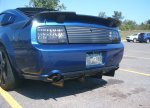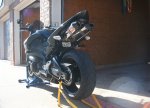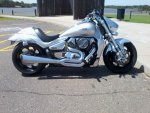On my Suzuki street bikes, you have an intake port on one side of the cylinder, down low on the cylinder wall. The exhaust port is higher up on the other side. The carburetors on the back, feed the air/fuel into the crankcase, where the oil is injected, straight onto the crank bearings. Oil is also direct injected under the pistons to directly oil the bearings on either end of the connecting rod. The air/fuel/oil mix in the crankcase is then drawn into the cylinder as the piston goes down.
It's complicated. As the piston comes down after combustion, the exhaust port is exposed first. Out goes the exhaust, which the evacuation of the exhaust sucks the intake in when the intake port down lower is exposed. Thus, when the piston starts rising, it closes the intake port first, but the exhaust is still open. The outgoing exhaust pulls some of the intake out with it, but the exhaust design causes a reversion, the exhaust flowing back toward the cylinder, pushing the fuel/air/oil back into the cylinder before the piston closes the exhaust port off. It makes for a very peaky power band. If you elongate the widest portion of the pipes to try and smooth out the power band, you end up losing some peak power. It's why two stroke pipes have that funky look they do, fat in the mid section, with stingers on the back.
My dad needed to borrow my first one, a 74, back in 79. It had J & R Power Pipes on it. I told him, do not, under any circumstances, grab a handful of throttle from a dead stop, expecting to take off like a bat out of hell. If you do, it'll just lug and you will end up with the front wheel in the air around 4500 rpms or so. He did it anyways, and came back rather quickly, shaking a bit. "Don't ever let me ride that beast again!" LOL!!















